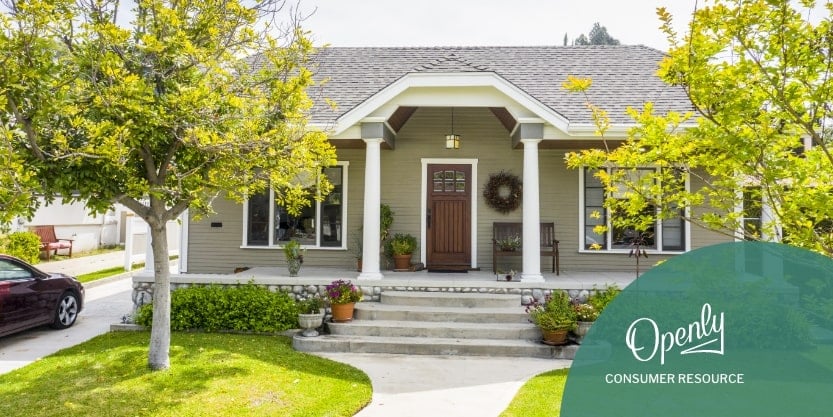Owning a home is often equated with a feeling of stability and security, but that doesn’t mean it's without risk. In the face of natural disasters, accidents, or unforeseen events, having the right homeowners insurance coverage is key.
Among the various types of home insurance policies an insurance company may offer, the HO-3 insurance policy is one of the most commonly available options. In this article, we'll discuss the components and benefits of an HO-3 insurance policy, and how to choose the right one to fit your needs.
At a glance:
- An HO3 policy is a form of homeowner's insurance that provides open-perils coverage for your house and other buildings on the property, while your personal belongings are protected under a named-perils basis.
- HO-3 insurance is popular due to its comprehensive coverage, flexibility, availability and affordability.
- Choosing the right HO-3 policy involves assessing factors like cost, additional coverage options, and the reputation of the insurance company.
Components of HO-3 policies
An HO-3 insurance policy consists of several components that work together to provide comprehensive home insurance coverage. The three main components of an HO-3 policy are dwelling coverage, personal property coverage, and personal liability coverage.
Dwelling coverage
Dwelling coverage is the cornerstone of any homeowners insurance policy, protecting the physical structure of the home, including walls, roof, floors, and attached structures (e.g., a garage or deck). In the event of damage or loss due to a covered peril (such as fire, windstorms, or theft) dwelling coverage helps repair or rebuild your home to its pre-loss condition.
Personal property coverage
If your personal belongings are damaged or destroyed by a covered peril, personal property coverage helps replace or repair them. Whether it's repairing your furniture after a fire or replacing your electronics after a break-in, personal property coverage ensures you're not financially on the hook for unexpected losses.
Liability coverage
Liability coverage protects you financially if someone is injured on your property, or if you accidentally damage someone else's property. It covers legal fees, medical expenses, and settlements or judgments up to the policy's limits. Whether it's a slip-and-fall accident on your driveway or accidental damage caused by a pet, personal liability coverage offers peace of mind and financial security.
Open perils vs named perils
Distinguishing between open perils coverage and named perils coverage helps homeowners understand the full extent of their insurance coverage and prepare for potential risks and losses effectively.
Open perils
An HO-3 policy typically provides open perils coverage for your dwelling. Open perils coverage extends protection against any perils unless they are explicitly excluded from your insurance policy. Common examples of events covered under open perils include fire, lightning, vandalism, theft, and damage from aircraft or vehicles.
Named perils
Named perils coverage outlines specific risks or perils that are covered by the insurance policy. This means that only the perils explicitly listed in the policy are covered, and any other events or hazards are excluded from coverage. Common named perils include fire, windstorm, hail, theft, vandalism, and certain types of water damage. While named perils coverage offers protection against specific risks like fire, windstorm, and theft, it may not cover all potential perils, leaving homeowners vulnerable.
What is not included in an HO-3 policy
While an HO-3 insurance policy provides broad coverage, it typically excludes certain risks or perils. Exclusions commonly found in HO-3 policies may include:
- Earth movements, including earthquakes and other seismic activity, landslides, and sinkholes
- Flooding, including tidal waves, river overflow and flash floods
- General wear and tear, or damage due to maintenance neglect
- Business activities, including damage or liability from business conducted on the property
- Losses arising from intentional acts resulting in damage or loss
- Damage caused by nuclear hazards
- Losses related to war or military action
In addition, high-value items may have limited coverage. This includes jewelry, art, or other objects whose value may exceed the personal property coverage or replacement cost coverage limits of an HO-3 policy. Homeowners with these types of high-value items may want to add scheduled property coverage via an endorsement to their homeowners policy.

Benefits of HO-3 insurance
The average cost of homeowners insurance in the United States is $1,759 per year.1 However, the cost of HO-3 insurance can vary based on factors such as location, the value of the home, and the desired additional coverage limits. That’s why it’s important to understand the benefits associated with your home insurance policy; and to make sure you are getting the home insurance coverage you need.
Availability
HO-3 policies are widely available and popular among homeowners, offering reliable protection and peace of mind for the majority of homeowners' insurance needs.
Affordability
Despite their comprehensive coverage, HO-3 policies are often one of the more affordable types of homeowners insurance, making them an attractive option for budget-conscious homeowners. HO-3 insurance is cost effective, offering robust coverage at competitive rates.
Coverage
HO-3 policies typically offer comprehensive insurance coverage for the dwelling and personal belongings, providing homeowners with peace of mind.
Flexibility
HO-3 policies can be tailored to fit the individual needs of homeowners by adjusting coverage levels and adding endorsements or riders.
Comparing HO-3 policies
HO-3 policies account for over 78% of active homeowners insurance policies in the United States.2 Needless to say, there are a lot of available options for homeowners looking for home insurance coverage. And a lot of information to compare.
It's important to dispel common misconceptions about HO-3 policies, such as the belief that they only cover the structure of the home and not personal belongings. In reality, HO-3 policies offer comprehensive coverage for both dwelling and personal property, making them a preferred choice for many homeowners. But that doesn’t mean they are all the same.
When comparing HO-3 policies, several key differences emerge. To effectively compare HO-3 policies, we recommend homeowners follow the seven steps outlined below.
1. Assess coverage needs
Determine your specific coverage needs for dwelling, personal property, and liability based on your home’s unique factors, such as the value of your house, personal belongings inventory, and any potential risks in your area (including weather, geography, and crime).
2. Review policy forms
Review the details of each HO-3 policy form offered by different home insurance providers. Pay close attention to the coverage limits, exclusions, and deductibles to determine whether or not the policy suits your financial situation.
3. Compare coverage options
Evaluate the coverage options offered by each HO-3 policy, including available endorsements or riders for specific risks (or items).
4. Consider cost
Compare premiums for each HO-3 policy, taking into account deductibles and any discounts offered by the insurance provider. It’s important to ensure that the cost of a policy aligns with your budget without compromising coverage.
5. Research providers
Research the reputation and financial stability of insurance providers. Read customer reviews and complaints to gauge the quality of service and claims handling.
6. Evaluate customer service
Consider the level of customer service offered by each insurance provider, including responsiveness and ease of communication.
7. Consult with an agent
Seek guidance from a knowledgeable insurance agent who can help you navigate the complexities of insurance and find the best policy to fit your needs.
Choosing the right HO-3 insurance policy
Choosing the right HO-3 policy involves balancing budget, coverage needs, and the reputation of the insurance provider. Understanding the components, coverage types, benefits, and comparisons with other policies like HO-5, enables homeowners to make informed decisions to protect their property and personal belongings. While HO-3 policies offer solid protection, HO-5 policies provide more expansive open-perils coverage for both your dwelling and personal belongings, which may better suit your needs.
At Openly, we offer high value home insurance coverage through independent agents in various states. We can help you find a trusted home insurance agent near you to guide you in purchasing the right policy. Visit us to explore your options and secure tailored coverage solutions for your home.
* We provide this information to help you understand insurance. Any coverage is subject to the terms of your policy. Please refer to your policy and declaration page for complete coverage details.
1 Shannon Martin. “Average homeowners insurance cost in March 2024.” Bankrate. Published 1 March 2024. Accessed 12 March 2024. https://www.bankrate.com/insurance/homeowners-insurance/homeowners-insurance-cost/
2 National Association of Insurance Commissioners. “Dwelling Fire, Homeowners Owner-Occupied, and Homeowners Tenant and Condominium/Cooperative Unit Owner’s Insurance Report: Data for 2021.” NAIC. Published December 2023. Accessed 5 March 2024. https://content.naic.org/sites/default/files/publication-hmr-zu-homeowners-report.pdf




